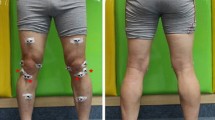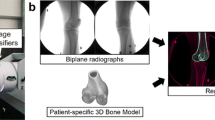Abstract
Purpose
While many studies about anterior-cruciate-ligament-deficient (ACLD) patients have demonstrated functional adaptations to protect the knee joint, an increasing number of patients undergo ACL reconstruction (ACLR) surgery in order to return to their desired level of activity. The purpose of this study was to compare 3D kinematic patterns between individuals having undergone ACLR with their healthy contralateral knee and a control group.
Methods
Three-dimensional kinematic data were obtained from 15 patients pre- and post-ACLR, 15 contralateral knees and 15 healthy controls. Data were recorded during treadmill walking at self-selected speed. Flexion/extension, external/internal tibial rotation, adduction/abduction and anterior/posterior tibial translation were compared between groups.
Results
ACLR knees showed a significantly higher knee-joint extension during the entire stance phase compared with ACLD knees. However, ACLR knees still showed a deficit of extension compared with healthy control knees. In the axial plane, there was no significant difference in pre- and postoperative kinematic data. Significant difference was achieved between ACLR knees and healthy control knees, specifically between 28 and 34 % and 44 and 54 % of the gait cycle. There was no significant difference in anterior–posterior translation or coronal plane between groups.
Conlusion
Following ACL reconstruction, patients have better clinical and kinematic parameters. Despite improvements, knee kinematics during gait in the ACLR group differed from the control group. These kinematic changes could lead to abnormal loading in the knee joint and initiate the process for future chondral degeneration.



Similar content being viewed by others
References
Li RT, Lorenz S, Xu Y et al (2011) Predictors of radiographic knee osteoarthritis after anterior cruciate ligament reconstruction. Am J Sports Med 39:2595–2603. doi:10.1177/0363546511424720
Rupp S, Müller B, Seil R (2001) Knee laxity after ACL reconstruction with a BPTB graft. Knee Surg Sport Traumatol Arthrosc 9:72–76. doi:10.1007/s001670000177
Grossman MG, ElAttrache NS, Shields CL, Glousman RE (2005) Revision anterior cruciate ligament reconstruction: Three- to nine-year follow-up. Arthrosc J Arthrosc Relat Surg 21:418–423. doi:10.1016/j.arthro.2004.12.009
Asano H, Muneta T, Shinomiya K (2002) Evaluation of clinical factors affecting knee pain after anterior cruciate ligament reconstruction. J Knee Surg 15:23–28
Zhang L-Q, Shiavi RG, Limbird TJ, Minorik JM (2003) Six degrees-of-freedom kinematics of ACL deficient knees during locomotion-compensatory mechanism. Gait Posture 17:34–42
Lorbach O, Wilmes P, Theisen D et al (2009) Reliability testing of a new device to measure tibial rotation. Knee Surg Sports Traumatol Arthrosc 17:920–926. doi:10.1007/s00167-009-0772-6
Espregueira-Mendes J, Pereira H, Sevivas N et al (2012) Assessment of rotatory laxity in anterior cruciate ligament-deficient knees using magnetic resonance imaging with Porto-knee testing device. Knee Surg Sports Traumatol Arthrosc 20:671–678. doi:10.1007/s00167-012-1914-9
Arnold MP, Duthon V, Neyret P, Hirschmann MT (2013) Double incision iso-anatomical ACL reconstruction: the freedom to place the femoral tunnel within the anatomical attachment site without exception. Int Orthop 37:247–251. doi:10.1007/s00264-012-1681-8
De Guisea JA (1996) Improving in vivo knee kinematic measurements: application to prosthetic ligament analysis. The knee 3:179–190
Magnussen RA, Neyret P, Cheze L, Lustig S (2012) The KneeKG system: a review of the literature. Knee Surg Sport Traumatol Arthrosc 20:633–638. doi:10.1007/s00167-011-1867-4
Shabani B, Bytyqi D, Lustig S et al (2014) Gait changes of the ACL-deficient knee 3D kinematic assessment. Knee Surg Sports Traumatol Arthrosc. doi:10.1007/s00167-014-3169-0
Sati M, De Guise JA, Drouin G (1997) Computer assisted knee surgery: Diagnostics and planning of knee surgery. Comput Aided Surg 2:108–123. doi:10.1002/(SICI)1097-0150(1997)2:2<108::AID-IGS4>3.0.CO;2-3
Hagemeister N, Parent G, Van de Putte M et al (2005) A reproducible method for studying three-dimensional knee kinematics. J Biomech 38:1926–1931. doi:10.1016/j.jbiomech.2005.05.013
Gao B, Zheng NN (2010) Alterations in three-dimensional joint kinematics of anterior cruciate ligament-deficient and -reconstructed knees during walking. Clin Biomech (Bristol, Avon) 25:222–229. doi:10.1016/j.clinbiomech.2009.11.006
Freiwald J, Jäger A, Starker M (1993) EMG-assisted functional analysis within the scope of follow-up of arthroscopically managed injuries of the anterior cruciate ligament. Sportverletz Sportschaden 7:122–128
Arciero RA, Scoville CR, Snyder RJ et al (1996) Single versus two-incision arthroscopic anterior cruciate ligament reconstruction. Arthroscopy 12:462–469
Ferber R, Osternig LR, Woollacott MH et al (2004) Bilateral accommodations to anterior cruciate ligament deficiency and surgery. Clin Biomech 19:136–144. doi:10.1016/j.clinbiomech.2003.10.008
Johansson H, Sjölander P, Sojka P (1990) Activity in receptor afferents from the anterior cruciate ligament evokes reflex effects on fusimotor neurones. Neurosci Res 8:54–59. doi:10.1016/0168-0102(90)90057-L
Solomonow M, Baratta R, Zhou BH et al (1987) The synergistic action of the anterior cruciate ligament and thigh muscles in maintaining joint stability. Am J Sport Med 15:207–213
Bush-joseph CA, Hurwitz DE, Patel RR et al (2001) Dynamic Function After Anterior Cruciate Ligament Reconstruction with Autologous Patellar Tendon. Am J Sports Med Am J Sports Med 29:36–41
Wang H, Fleischli JE, Zheng NN (2013) Transtibial versus anteromedial portal technique in single-bundle anterior cruciate ligament reconstruction: outcomes of knee joint kinematics during walking. Am J Sports Med 41:1847–1856. doi:10.1177/0363546513490663
M H, M D, G C, et al. (2007) Reconstruction of the anterior cruciate ligament: dynamic strain evaluation of the graft. Knee Surg Sport Traumatol Arthrosc 15:233–41
Butler DL, Guan Y, Kay MD et al (1992) Location-dependent variations in the material properties of the anterior cruciate ligament. J Biomech 25:511–518. doi:10.1016/0021-9290(92)90091-E
Lording TD, Lustig S, Servien E, Neyret P (2014) ScienceDirect Lateral reinforcement in anterior cruciate ligament reconstruction. Asia-Pacific J Sport Med Arthrosc Rehabil Technol 1:3–10. doi:10.1016/j.asmart.2013.12.002
Decker LM, Moraiti C, Stergiou N, Georgoulis AD (2011) New insights into anterior cruciate ligament deficiency and reconstruction through the assessment of knee kinematic variability in terms of nonlinear dynamics. Knee Surg Sports Traumatol Arthrosc 19:1620–1633. doi:10.1007/s00167-011-1484-2
Tashman S (2004) Abnormal Rotational Knee Motion During Running After Anterior Cruciate Ligament Reconstruction. Am J Sports Med 32:975–983. doi:10.1177/0363546503261709
Schipplein OD, Andriacchi TP (1991) Interaction between active and passive knee stabilizers during level walking. J Orthop Res 9:113–119. doi:10.1002/jor.1100090114
Andriacchi TP, Favre J (2014) The nature of in vivo mechanical signals that influence cartilage health and progression to knee osteoarthritis. Curr Rheumatol Rep 16:463
Dye SF (1996) The knee as a biologic transmission with an envelope of function: a theory. Clin Orthop Relat Res 325:10–18
Author information
Authors and Affiliations
Corresponding author
Rights and permissions
About this article
Cite this article
Shabani, B., Bytyqi, D., Lustig, S. et al. Gait knee kinematics after ACL reconstruction: 3D assessment. International Orthopaedics (SICOT) 39, 1187–1193 (2015). https://doi.org/10.1007/s00264-014-2643-0
Received:
Accepted:
Published:
Issue Date:
DOI: https://doi.org/10.1007/s00264-014-2643-0




